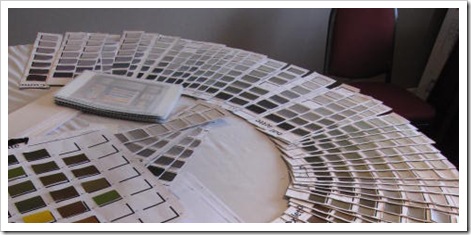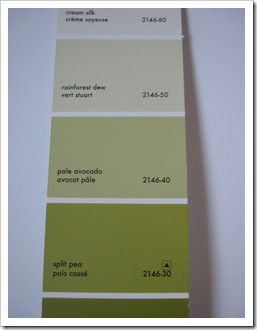How Should an Interior Designer Use a Fan Deck
True Colour ExpertUnderstanding Undertones
What Everyone Should Know about Fan Decks
Have you ever looked at a darker or lighter colour on a strip of colours from a fan deck and thought "That doesn't look right'. Well, you were probably correct. To choose colours accurately, you need to rely on your colour trained eye (or your colour designer) to find a colour in the deck that complements the one you want. If you just go up or down the strip of colours in the fan deck, you might end up with a bad colour combination (no such thing as a bad colour, just lots of bad combinations).
In the summer I was hired for a short-term contract to help compile a fan deck for a large paint company. Pat Verlodt (below right), who has been in the colour industry for over 40 years, was in charge of the project. She also contributes to this colour blog. Denise Turner (below left) from ColorTurners in California was also part of our team!
 Denise Turner and Pat Verlodt
Denise Turner and Pat Verlodt
The colour chips from the current deck are cut and pasted on bigger white strips of paper (below). Then we fill in the blanks. . . how? With a stack of competitors fan decks. The reason it's done this way is that it's way too cost prohibitive to just take a bunch of saturated (dark colours) and commission the lab to come up with a bunch of let-downs (a gradation of lighter colours). So instead we simply look through fan decks to find the closest one that we think works and that's how a new fan deck is born.

Maria Killam
Then we start at the top of the colour wheel with the cleanest colours and tape them up from left to right all over the conference room. See the reds? Well we definitely don't need all the lightest shades of bright pinks that you would end up with if you just had one red chip on each strip so some of them have 2 or 3.
Next I got the task of arranging all the neutral/muddy colours so that they could go up on the wall underneath the rest. It was after I had done this job that I was told "Welcome to the Team" Whew, I guess that means I can keep my day job of being a colourist and teaching it too 🙂
 Photo by Maria Killam
Photo by Maria Killam
There are many times during consultations where I have pulled out a colour one shade darker (in the same strip) and my client and I have both said ewwww. Now you know why you don't like it. Because it was simply the best available colour at the time. The perfect lighter or darker shade for you or your client is not necessarily on the same strip. Sometimes, it's not even in the fan deck. Ever tried in vain to find a colour for your client to match her bedspread and it wasn't there? Well there are lots of holes for the right neutrals in many fan decks (for example), so if you can't find it, it's because it's probably not in that deck.

The Historical Colour section of a Benjamin Moore fan deck (above) can also be misleading if you don't understand how it works. I have heard many designers complain that it's set up this way but it is the Historical Colour Collection (they can't add more simply so you have the right gradation of colour).
Benjamin Moore has simply taken this collection and arranged them on a fan the best way possible. So while some of them look like they go from light to dark, others do not look right at all. Like HC-95 Sag Harbor Gray (above), see how dirty it looks in comparison to Richmond gray or Old Salem Gray? Richmond Gray is a lighter shade of Old Salem Gray but Sag Harbor is just hanging out in the middle. Is it a bad colour? Of course not, as I said in this post, Clean always Trumps Dirty, whenever you are comparing a dirty colour to a clean colour the clean colour will look better. Context is EVERYTHING.
 See 2147-30 Jalapeno Pepper? If you were looking for one shade darker than dill pickle but you didn't like what you see? Keep looking and COMPARE to find one that you like.
See 2147-30 Jalapeno Pepper? If you were looking for one shade darker than dill pickle but you didn't like what you see? Keep looking and COMPARE to find one that you like.
 You might like split pea better or you might think it's too yellow? Either way you slice it, you could use dill pickle and split pea together because they are both still yellow enough and clean enough to look good together.
You might like split pea better or you might think it's too yellow? Either way you slice it, you could use dill pickle and split pea together because they are both still yellow enough and clean enough to look good together.

See the lightest shade on this row, HC-78? Well it has a purple undertone so is it a let-down of Alexandria Beige? No. It's comparing one colour chip to another that will give you the combination you want NOT just going up or down on the strip. I have had this conversation so many times with clients, it's why you are getting this tutorial here on my blog today.
If you want to learn to 'See Colour like a Pro' Check out my True Colour Expert Training where you will not only develop the confidence to start 'trusting your eye on seeing undertones of colour', you will learn what elements make a room work in addition to the ability to select the right colours for you or your clients space to 'pull your space together'. Click here for more details.
And if you are a decorator, designer, stager or a creative person considering starting your own design business? Colour is the foundation to be successful. If you would like to have a conversation with me to find out if this course is right for you, email me with your phone number.
Download my eBook, It's All in the Undertones. If you have a computer, you can download my book!
If you would like your home to fill you with happiness every time you walk in, contact me.
To make sure the undertones in your home are right, get some large samples!
If you would like to learn to how choose the right colours for your home or for your clients, become a True Colour Expert.
Related posts:
Colour is Context
Insider Secrets to Seeing Colour like a Pro
Are your Colours Married?
New to this Blog? Click here ; Subscribe to my free Monthly Newsletter; Become a True Colour Expert
While you're here, subscribe to this feed so you don't miss out!
How Should an Interior Designer Use a Fan Deck
Source: https://mariakillam.com/what-everyone-should-know-about-fan-decks/
0 Response to "How Should an Interior Designer Use a Fan Deck"
Mag-post ng isang Komento